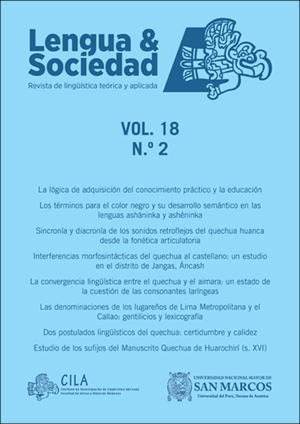Color terms for black and their semantic development in Ashaninka and Asheninka language
DOI:
https://doi.org/10.15381/lengsoc.v18i2.22328Keywords:
Ashaninka, reconstruction, lexicalization, category, opacityAbstract
The main purpose of this research is the analysis of kisaari, cheenkari, potsitari and ponaari, terms that belong to black-color notion in Ashaninka and Asheninka language, and are the result of the codification of the perception of jumping aspects of various referents of nature, showed in the opacity presented by its structure. Their reconstruction is grounded in lexicalization theory and their belonging to the category, in the theory of basic color terms and that of prototypes. The results show that kisaari was built from the dark aspect of a seed species; cheenkari, from the appearance of blackish spots of a snake species; potsitari, from the appearance of a reddish-blackish natural dye, and ponaari, from the comparison of the swelling of a body with the physical appearance of the area of the injured skin.
References
Berlin, B., y Kay, P. (1969). Basic color terms: their universality and evolution. Berkeley y Los Angeles, Estados Unidos: University of California.
Cuenca, M. J. y Hilferty, J. (1999). Introducción a la lingüística cognitiva. Barcelona, España: Ariel.
Delgado, E. (1896). Vocabulario del idioma de las tribus campas. Boletín de la Sociedad Geográfica de Lima, 5, 445-457.
Elvira, J. (en prensa). Aproximación al concepto de lexicalización. En J. Rodríguez Molina y DM Sáez Rivera (Eds.), Diacronía, lengua española y lingüística (pp. 21-41). Madrid: Síntesis. Recuperado de https://www.uam.es/personal_pdi/filoyletras/javel/lexicalizacion.pdf
INEI. (2018). Censos Nacionales 2017: XII de Población, VII de Vivienda y III de Comunidades Indígenas. Lima, Perú: Dirección Técnica de Demografía y Estudios Sociales y Centro de Investigación y Desarrollo del Instituto Nacional de Estadística e Informática (INEI). Recuperado de https://www.inei.gob.pe/media/MenuRecursivo/publicaciones_digitales/Est/Lib1539/libro.pdf
Jacinto, P. (2019). Primer Informe: Pueblo asháninka. Manuscrito presentado para su publicación.
Kuehni, R. (2008). Why colour words are really colour words. En Journal of the Royal Anthropological Institute (N. S.), 14, 886-889. Recuperado de http://www1.icsi.berkeley.edu/~kay/wierz.colour.comment.pdf
Leclerc, C. y Adam, L. (1890). Arte de la lengua de los indios antis o campas. París, Francia: J. Maisonneuve.
Medina, A. (2011). Estudio descriptivo de la frase nominal en el asháninka del Alto Perené (Tesis de licenciatura). Universidad Nacional Mayor de San Marcos. Recuperado de http://cybertesis.unmsm.edu.pe/bitstream/handle/cybertesis/1228/Medina_gp.pdf;jsessionid=CABD14E0A108618997A68BEDE1BFEB15?se- quence=1
Mohammad, S. (2011). Colourful language: Measuring word-colour associations. En Proceedings of the 2nd Workshop on Cognitive Modeling and Computational Linguistics (pp. 97-106). Ottawa: Association for Computational Linguistics. Recuperado de http://www.anthology.aclweb.org/W/W11/W11-06.pdf#page=107
Parodi, F. (2002). La cromosemiótica. El significado del color en la comunicación visual. Comunicación, 3(2). Recuperado de http://sisbib.unmsm.edu.pe/bibvirtualdata/publicaciones/comunicacion/n3_2002/a07.pdf
Rosch, E., Mervis, C. B., Gray, W. D., Johnson, D. M., Boyes-Braem, P. (1976). Basic objects in natural categories. Cognitive psychology, 8(3), 382-439.
Rosch, E., y Lloyd, B. B.(1978). Cognitionand Categorization. Recuperado de http://citeseerx.ist.psu.edu/viewdoc/download?doi=10.1.1.307.5210&rep=rep1&type=pdf
Sala, G. (1905). Diccionario, gramática y catecismo Castellano, Inga, Amueixa y Campa. Lima, Perú: Tip. Nacional F. Barrionuevo.
Shaver, H. (1996). Diccionario Nomatsiguenga-Castellano Castellano-Nomatsiguenga. Pucallpa, Perú: Instituto Lingüístico de Verano.
Snell, B. A., Chávez, I., Cruz, V., Collantes, A., Pereira, J, E.(2011). Diccionariomatsigenka-castellano con índice castellano, notas enciclopédicas y apuntes gramaticales. En Wise, M. R. (Ed.), Serie Lingüística Peruana (Vol. 56). Recuperado de https://www.sil.org/system/files/reapdata/95/79/38/95793891741272531054477784142915753324/mcbDIC_press.pdf
Solari, O. (2019). Los términos para el color blanco y su desarrollo semántico en la lengua asháninka. Manuscrito presentado para su publicación.
Solari, O. (2019). Etnosemántica de los colores en la lengua asháninka — una visión cognitiva, sincrónica y diacrónica (Tesis de maestría). Universidad Nacional Mayor de San Marcos, Lima. Recuperado de http://cybertesis.unmsm.edu.pe/handle/cybertesis/11149
Steinvall, A. (2002). English colour terms in context (Tesis doctoral). Umeå Universitet. Recuperado de http://www.diva-portal.org/smash/get/diva2:144764/FULLTEXT01.pdf
Touchaux, M. (1909). Apuntes sobre la gramática y el diccionario del idioma campa o lengua de los antis tal como se usa en el rio Apurímac. Lima: Imp. Nacional de Federico Barrionuevo. Recuperado de http://etnolinguistica.wdfiles.com/local-files/biblio%3atouchaux-1909-apuntes/touchaux_1909_apuntes_harvard.pdf
Valenzuela, J., Ibarretxe-Antuñano, I., Hilferty, J. (en prensa). La Semántica Cognitiva. Lingüística Cognitiva. En Ibarretxe-Antuñano, I. y Valenzuela, J. (Eds.). Lingüística cognitiva. Barcelona, España: Anthropos. Recuperado de: http://www.unizar.es/linguisticageneral/articulos/Valenzuela-Ibarretxe-Hilferty-SemCog.pdf
Downloads
Published
Issue
Section
License
Copyright (c) 2019 Oscar Augusto Solari Ruiz-Eldredge

This work is licensed under a Creative Commons Attribution 4.0 International License.
AUTHORS RETAIN THEIR RIGHTS
a. Authors retain their trade mark rights and patent, and also on any process or procedure described in the article.
b. Authors can submit to the journal Lengua y Sociedad, papers disseminated as pre-print in repositories. This should be made known in the cover letter.
c. Authors retain their right to share, copy, distribute, perform and publicly communicate their article (eg, to place their article in an institutional repository or publish it in a book), with an acknowledgment of its initial publication in the journal Lengua y Sociedad.
d. Authors retain theirs right to make a subsequent publication of their work, to use the article or any part thereof (eg a compilation of his papers, lecture notes, thesis, or a book), always indicating its initial publication in the journal Lengua y Sociedad (the originator of the work, journal, volume, number and date).



























